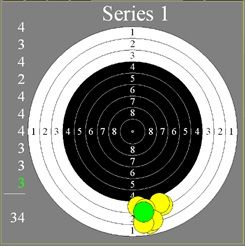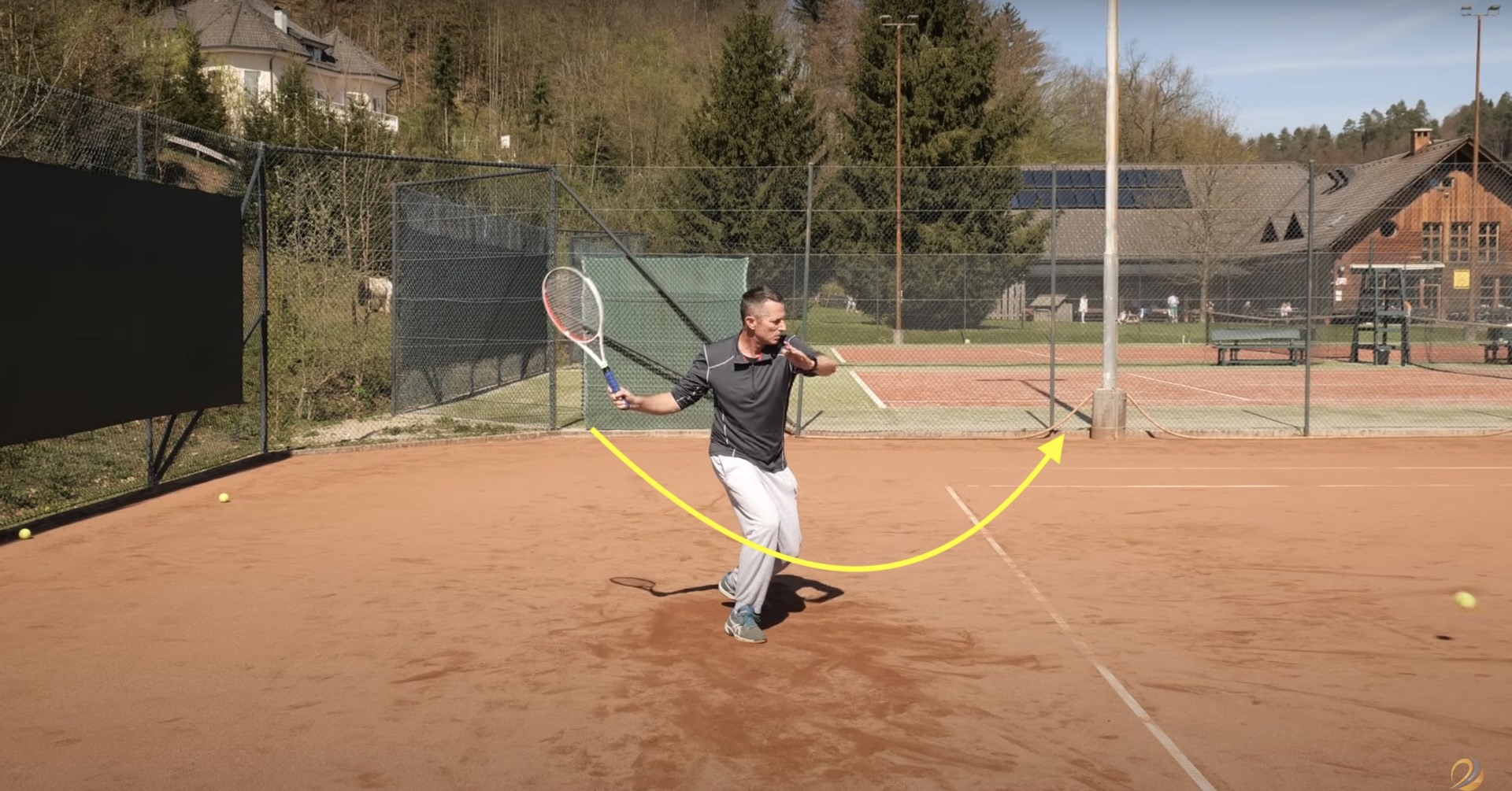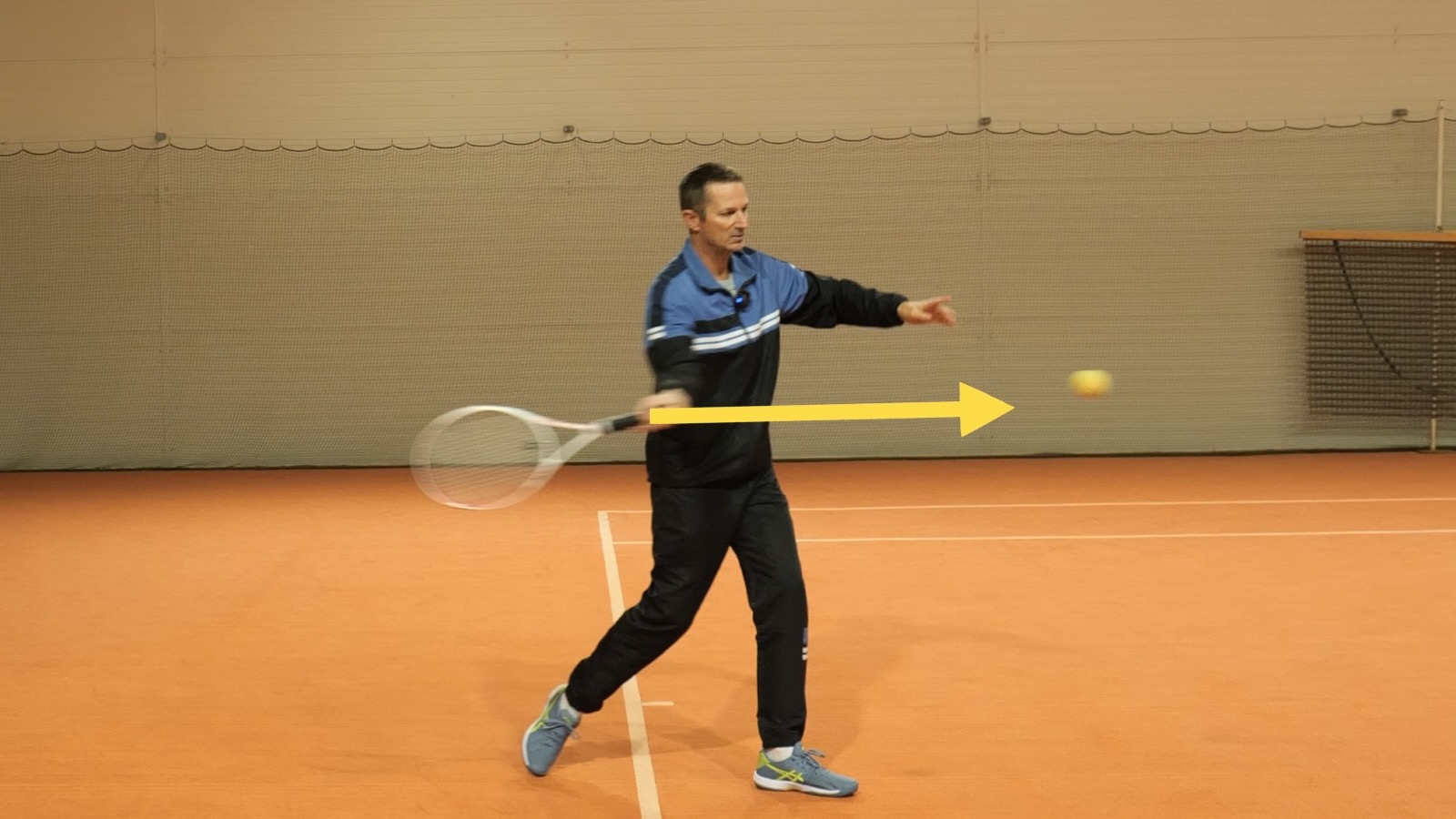When you’re working on the accuracy of your shots in tennis—whether it’s your serve, groundstrokes, volleys, or any other stroke—you can apply a simple principle of correcting and adjusting the shots that will lead to the fastest improvement in accuracy.
The Difference Between Accuracy And Precision
Accuracy and precision are easily confused, but can be defined in the following way:
Accuracy indicates proximity of measurement results to the true value, while precision is a measure of the repeatability, or reproducibility, of the measurement. (from http://extensionengine.com/accuracy-precison/)
The pictures below best explain the difference between accuracy and precision.

The difference between accuracy and precision (image from http://extensionengine.com)
In tennis, we talk mostly about accuracy and not precision because tennis shots are not precise.
High accuracy in tennis means that our shots are evenly spread around the target, but they are not grouped very close together (see image (c) above).
That’s because we’re hitting a moving round ball with a moving racquet, often times while we’re also moving!
It is simply too difficult to be precise in such a dynamic sport as tennis – except when it comes to serving!
When we serve, we can be much more precise. We’re not moving, we control the ball position (toss), we’re always at the same distance from the net, and the service box and the measurements of the court and the net are always the same.
Therefore, you will see a much higher precision with serves compared to other strokes that are played in various dynamic situations.
See Andy Murray here aim at the cans…
While he surely missed some of the serves that are not shown in this clip, you can see that he can actually hit the can often.
But, when it comes to groundstrokes (even in relatively easy situations where the balls are fed to him), the precision of the strokes is not very high.
Note in this video that Andy again has cans of balls placed as targets, but his spread around the targets is much bigger:
He of course knows that and is not disappointed when he misses the can. The can is there only to guide him and is not acting as the actual target that he has to hit.
In other words, missing the target is not a mistake—it simply gives Andy feedback on how precise his shots are.
So, in general, we talk about accuracy in tennis, and with the principle of self-correcting, we’ll improve both the accuracy and the precision of our shots.
The Principle Of Calibration
The idea of calibration comes from calibrating a scope on a rifle. When you aim at the target and shoot a few shots, you will quickly see where the bullets end up.

If your rifle was shooting like this, you would need to aim above the center (same distance) to hit the center. (image from http://guns.ie/tag/youtube/)
They might not end up exactly at the center of the target, but they will often times end up grouped together slightly off target.
That means that the gun is precise but not accurate (see the picture to the right). In other words, the scope points to a different spot than the rifle shoots projectiles.
The rifle will NOT change its direction; it will always shoot straight!
Therefore, the scope needs to be adjusted OR your aim needs to be adjusted!
In the same way, your serve probably “shoots” balls at a spot where most balls are grouped together (with less precision than the rifle, of course), yet they are not where you want them to be.
It is common sense to keep aiming at the target in order to hit it—and, yes, that works, but very slowly.
You are slowly inching closer to the target while consistently making the same type of mistake—meaning all your serves, for example, end up somewhat to the right.
What you need to do is aim to the other side of the target for the same distance that you missed in the first place.
If you missed by 3 feet to the right, you need to aim now 3 feet to the left of the target.
Your serve will keep serving where it’s serving—it’s much better to calibrate your “scope”!
What that means is that you need to adjust your aiming and aim 3 feet to the left.
Once you do that, you’ll most likely hit very close to the target. If you do that repeatedly, your mind (aiming) and body will then align, and eventually you will be able to aim at the target and actually land your shots close to it.
In other words, rather than trying to change your serve, change yourself by changing your aim.
Your serve is fine. You’re just aiming it at the wrong place.
Adjust your aim, and once you see the serve go into the target, there will be a SHIFT in your mind, and the targeting/aiming will correct itself.
“Bend yourself” rather than trying to bend the “serve”.
Apply the same principle when working on other strokes like the forehand, backhand, and volleys.
Just make sure to set your expectations right—your precision on other strokes will be lower because every ball is different and you’re hitting it from a different place on the court.
The Principle Of Self-Correction In Tennis
In summary, the fastest way to improve the accuracy (and precision) of your shots in tennis is to adjust your aim rather than trying to adjust the stroke.
If you aim into the target and your shot lands a foot to the left, do not try to adjust your stroke but rather aim a foot to the right of the target!
Your next shot will very likely land very close to the target, and your brain will realize the misalignment between the targeting system and the stroke and will quickly adjust it!





This video makes a lot of sense. I love you videos and always look forward to new ones.
Regards,
Steve
Thanks, Steve. A few more tips coming soon…
Very interesting. I keep on trying to help my son with his serve. I will definitely show him this.
Excellent post. Although it may seem far removed this approach reminds me of some things that Ed Deming taught the world about quality. One of the key elements is understanding the precision of your tools when defining the margin of error. In one of his examples involving sowing upholstery in a car the precision of the machine was /- 0.25″. Human operators would often try and “correct” the path of the needle to get it closer to the perfect location but by doing so actually *increased* the error to nearly 0.50″. You have to design the people and the process for the limit of precision.
Trying to hit a specific point on court provides a distribution that shows what level of precision you have for that shot. Then knowing what it is you can take the most correct aim for hitting the shot say 70-80% of the time.
With all the moving parts (incoming ball, position on the court, your body and racquet) this is far more difficult than a machine but the idea is similar and I think a useful framework.
Thanks for sharing your good work!
The matrix video makes me think that we read the same types of books.
Reality is all in your interpretation.
Thanks for the videos
Tomaz! Great post. If I had to paraphrase, most people (including me in the past) would try and change what their body did. You suggest simply trying to correct the shot through a slight adjustment. Then adjust again and again. It sounds so simple and yet most people try to change and control their body parts. Your ideas are so simple and easy to implement.
Thanks again!
My problem is there is no consistency. Where I miss depends on the speed, direction and spin of the incoming ball, whether I hit it too late or too early… etc. This idea works well when practicing with a ball machine, but in a dynamic situation as in a match, how can I improve the accuracy?
I agree absolutely with you on the principle of adjusting the aim rather than adjusting the stroke for accuracy improvement. You helped me to understand it very clearly so I’d like it apply that principle to improve my ground strokes as well. Many thanks for your great tip!
Love this tennis tip – there is no spoon!
Your vidéos are beautiful. Very créative and interesting for tennis and life.
Thanks à lot.
Tomaz,
Your great understanding of tennis, I think, cored reality, science, and relax attention to detail.
Thanks for this ray of light!
Aris
You’re welcome, Aris! Hoping to share more interesting ideas soon…
The allegory of matrix was so “accurate” and “precise”!
Hey Tomaz, I really appreciate the way you teach tennis and to be perfectly honest it is the best tennis instructional website out there. However, your website seems to lack a two handed backhand video. If you could make one that would be awesome.
Thanks, Edward! Please give me more specific questions about a two-handed backhand – so I can better answer you…
A two-handed backhand about feel, topspin, but most importantly I would like to know how to hit a clean and consistent two handed backhand.
It seem that whenever I read about serve placement no one ever explain HOW you actually aim the ball. Or in other words what are the exact steps to aim a serve at the T? Interesting……..
That’s because it’s not a conscious process, Ed. You aim very similar to aiming as you would “aim” if you were to throw the ball with your hand.
You simply “want” the ball to go down the T. Then you see how much you missed and you try to adjust with your next shot. That’s really it.
It takes thousands of serves to get it right…
Thanks for the tips. I actually have experience with riflery, archery, throwing, of course… I always, always always use this method in all of those disciplines and many others.
I feel kind of stupid now, though, because I never used it with tennis.
I’m so new to it and lack confidence in my form, so any error is blamed on form and I try to change my form to adjust my point of impact, rather than changing my point of aim.
Of course this results in your predicted outcome, loss of consistency or precision, and no improvement to accuracy.
Now i actually have a tip that can help me, finally, rather than all the stupid videos that say I have to pronate my wrist, throw the ball higher, pose longer, bend my knees more, all of them adding new technique and form, all of them making consistency worse in the short term.
All this time wasted, and I never had a problem with form. My first serve was well over 100mph because I have extensive experience in throwing, actually breaking the Canadian juvenile record for javelin in an unsanctioned event, several provincial gold medals for shot put, discus, javelin and hammer throws, pitching in softball and baseball, also competing in badminton.
I can really throw well, and it translates easily to tennis serves. So all the videos trying to make me hit harder or more effectively… wtf?
That’s what you get for blind coaching, as in, someone that has never seen you hit telling you how to fix it.
Thanks for sharing, David, really appreciate your feedback!
This is so helpful! Thank you Tomaz.